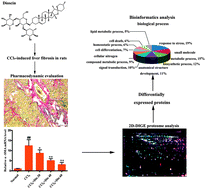Quantitative chemical proteomics for investigating the biomarkers of dioscin against liver fibrosis caused by CCl4 in rats†
Abstract
In the present work, the effect of dioscin against liver fibrosis in rats caused by carbon tetrachloride (CCl4) was confirmed. Then, the differentially expressed proteins from rat liver were identified using two-dimensional differential in-gel electrophoresis technology. Ten new biomarkers including protein disulfide isomerase A3, selenium-binding protein 1, glutamine synthetase, senescence marker protein 30, hemopexin, keratin 8, keratin 18, vimentin, Annexin A5 and dermatopontin associated with liver fibrosis were found and validated, and new insights through affecting multiple drug targets and biological processes were also provided to reveal the mechanisms of dioscin against hepatic fibrosis for the first time.


 Please wait while we load your content...
Please wait while we load your content...